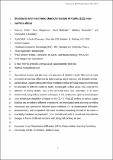Files in this item
Structural and electronic characterisation of Cu/Au(111) near-surface alloys
Item metadata
| dc.contributor.author | Grillo, Federico | |
| dc.contributor.author | Megginson, Rory | |
| dc.contributor.author | Batchelor, David | |
| dc.contributor.author | Muntwiler, Matthias | |
| dc.contributor.author | Baddeley, Christopher J. | |
| dc.date.accessioned | 2020-06-17T23:34:33Z | |
| dc.date.available | 2020-06-17T23:34:33Z | |
| dc.date.issued | 2019-06-18 | |
| dc.identifier | 258344332 | |
| dc.identifier | d2340e97-f73b-4c7a-a860-98614f83a98f | |
| dc.identifier | 000478967400030 | |
| dc.identifier | 85069489468 | |
| dc.identifier.citation | Grillo , F , Megginson , R , Batchelor , D , Muntwiler , M & Baddeley , C J 2019 , ' Structural and electronic characterisation of Cu/Au(111) near-surface alloys ' , Japanese Journal of Applied Physics , vol. 58 , no. SI , SIIB09 . https://doi.org/10.7567/1347-4065/ab1b5b | en |
| dc.identifier.issn | 0021-4922 | |
| dc.identifier.other | ORCID: /0000-0001-9961-1212/work/58755455 | |
| dc.identifier.other | ORCID: /0000-0001-9750-6494/work/58755467 | |
| dc.identifier.uri | https://hdl.handle.net/10023/20098 | |
| dc.description | The Engineering and Physical Sciences Research Council (EPSRC) is acknowledged for the funding of FG (EP/M029077/1) and RM (EP/506631/1). The Paul Scherrer Institut, Villigen, Switzerland is acknowledged for provision of synchrotron radiation beamtime at the PEARL beamline of the SLS. Nicolas Bachellier, Daria Sostina and Patrick Ascher are thanked for assistance. DB thanks the Helmholtz Association Program MML for financial funding in this work. | en |
| dc.description.abstract | Geometrical structure and electronic characteristics of ultrathin metallic films of one metal on another are strongly influenced by factors such as lattice mismatch and formation of near-surface alloys. Doped systems often show modified chemical-physical properties which may be amenable to different reactivity routes. Copper-gold surface alloys have received the attention of several studies, only a few of which have been undertaken in an UHV environment, using surface sensitive techniques. In this contribution, systems produced upon room temperature deposition of copper on the (22×√3)-Au(111) surface, at various copper loadings and annealed to different temperatures, are investigated using scanning tunnelling microscopy and synchrotron radiation based techniques (X-ray photoelectron diffraction, photoemission), with comparison with some theoretical modelling. Overall the fcc lattice is essentially maintained on preparation. Upon thermal treatments structural and compositional changes, in favour of alloyed structures with tetragonal packing, are seen. | |
| dc.format.extent | 5 | |
| dc.format.extent | 951086 | |
| dc.language.iso | eng | |
| dc.relation.ispartof | Japanese Journal of Applied Physics | en |
| dc.subject | X-ray Photoelectron Diffraction (XPD) | en |
| dc.subject | Surface alloys | en |
| dc.subject | Synchrotron | en |
| dc.subject | Photoemission, Scanning Tunnelling Microscopy (STM) | en |
| dc.subject | QD Chemistry | en |
| dc.subject | DAS | en |
| dc.subject.lcc | QD | en |
| dc.title | Structural and electronic characterisation of Cu/Au(111) near-surface alloys | en |
| dc.type | Journal article | en |
| dc.contributor.sponsor | EPSRC | en |
| dc.contributor.institution | University of St Andrews. School of Chemistry | en |
| dc.contributor.institution | University of St Andrews. EaSTCHEM | en |
| dc.identifier.doi | 10.7567/1347-4065/ab1b5b | |
| dc.description.status | Peer reviewed | en |
| dc.date.embargoedUntil | 2020-06-18 | |
| dc.identifier.grantnumber | EP/M029077/1 | en |
This item appears in the following Collection(s)
Items in the St Andrews Research Repository are protected by copyright, with all rights reserved, unless otherwise indicated.

